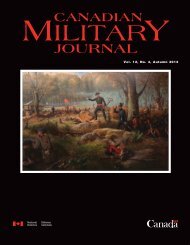Create successful ePaper yourself
Turn your PDF publications into a flip-book with our unique Google optimized e-Paper software.
Japanese balloons. If there were any<br />
further cases of balloons having been<br />
brought down, these would surely have<br />
been noted in the Operational Record<br />
Books (ORBs) of the squadrons, as well<br />
as the ORBs and weekly operational<br />
summaries of the Commands. A review<br />
of these documents for Western Air Command and<br />
its squadrons indicates that these were the only<br />
documented incidents. As the balloons were the only<br />
actual Japanese threat that the RCAF faced on the<br />
west coast after 1943, it would, indeed, have been<br />
highly irregular for the squadrons or commands not<br />
to have duly noted such an incident. 52<br />
Two other incidents have been noted in literature<br />
suggesting that balloons were shot down over Canadian<br />
territory. An incident off Kunghit Island, near the<br />
Queen Charlotte Islands, indicated that a balloon was<br />
shot down, presumably by the RCAF. 53 Further, a balloon<br />
incident on 13 March 1945 near Port Hardy was initially<br />
reported as actually being two balloons, with an RCAF<br />
aircraft shooting one down. 54 In both cases, those initial<br />
reports proved to be false. Pacific Command was eventually<br />
questioned about both incidents, since official United<br />
States records provided the initial data. The Command<br />
subsequently reported that the Kunghit Island incident<br />
was actually a case of an American merchant vessel<br />
spotting a balloon on the ocean and firing upon it.<br />
That of the two balloons near Port Hardy was, in effect,<br />
one balloon sighted by two separate aircraft. 55 Contrary<br />
to what was noted earlier, it was not shot down.<br />
Another report in Pacific Command files indicates<br />
that a balloon was reportedly shot down near Strathmore,<br />
Alberta, on 21 March 1945. There is no indication of<br />
this in any report of RCAF activities, nor in any<br />
operational record book. The only indication of aircraft<br />
involvement in balloon landings in this area is found<br />
in army files. Army reports indicate that information<br />
was obtained that an aircraft had shot down a balloon<br />
on 21 March in this region. However, the source has not<br />
been attributed. 56<br />
Conclusions<br />
Overall, Western Air Command prepared for the<br />
Japanese threat in an effective manner. At first,<br />
even before sufficient information was available to<br />
understand the threat, WAC maintained aircraft on<br />
alert in case the need arose to bring them down. Provision<br />
for gathering information from intact, downed balloons<br />
was also made. These activities were fundamentally<br />
conducted without direction from higher command.<br />
“Venus continued<br />
to be threatened by<br />
aerial attacks.”<br />
As the nature of the balloons became<br />
better known, resources were reallocated<br />
and attempts made to better detect and<br />
counter the threat. While some efforts were<br />
successful, factors beyond the control of<br />
WAC limited the success rate of aircraft<br />
interceptions.<br />
Factors such as darkness, weather, the altitude of<br />
the balloon and the timeliness of the reporting doubtlessly<br />
reduced the chances for Western Air Command to conduct<br />
successful intercepts. Radar’s ability to detect a balloon<br />
was also dubious and limited. Perhaps the greatest<br />
problem was one over which WAC had no realistic<br />
control. The problem of false reporting, particularly of<br />
the planet Venus, is one that any formation of the time<br />
would have faced with uncertainty – to not scramble<br />
an aircraft against a suspected sighting of Venus<br />
could have let an actual balloon slip through the<br />
defences. To the frustration of the fighter pilots, WAC<br />
had to scramble them against all sightings with a<br />
potential for a successful interception.<br />
Some aspects of the response to the threat were<br />
conducted through the activities of the JSC, which<br />
relieved WAC of informing local government officials<br />
and civilian pilots. This “jointness” also relieved WAC<br />
of the need to conduct several operational roles, such<br />
as responding to balloon landings. Jointness thereby<br />
allowed WAC to focus its attention on what it could do best.<br />
As for the Japanese, while they did not achieve<br />
their goal of setting the forests of western North<br />
America ablaze, they did tie up limited RCAF resources<br />
that could have been demobilized or been prepared<br />
for deployment to the Far East. However, Western Air<br />
Command possibly only maintained one fighter squadron<br />
beyond normal requirements to honour the balloon<br />
threat, while the Cansos and Venturas were nonetheless<br />
required for coastal surface surveillance.<br />
In the face of a new and singularly unique threat,<br />
Western Air Command created the conditions required<br />
to successfully engage the enemy’s weapon. They<br />
were prepared to act alone, and then responded well in<br />
a joint environment when that eventually arose. That<br />
more balloons were not brought down was not the fault<br />
of WAC or its pilots, but rather the circumstances related<br />
to the detection of the balloons over the large area of<br />
responsibility for the Command. The balloon campaign<br />
should therefore be considered an overall success.<br />
66 Canadian Military Journal ● Summer 2005





